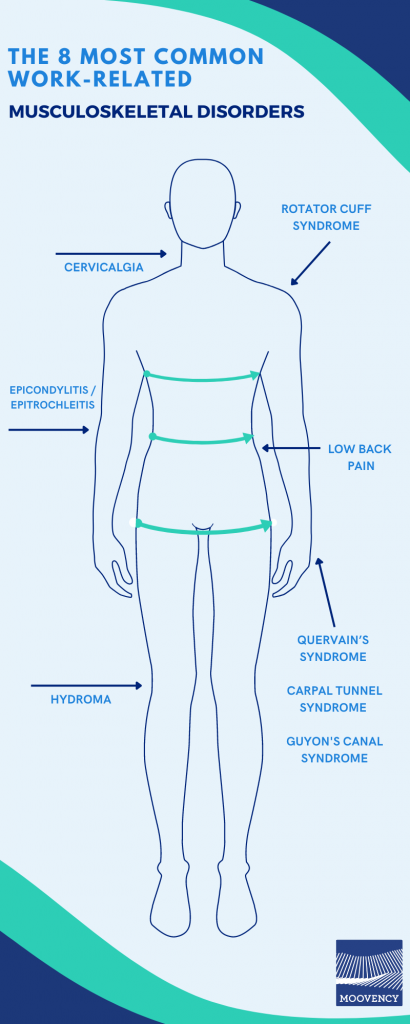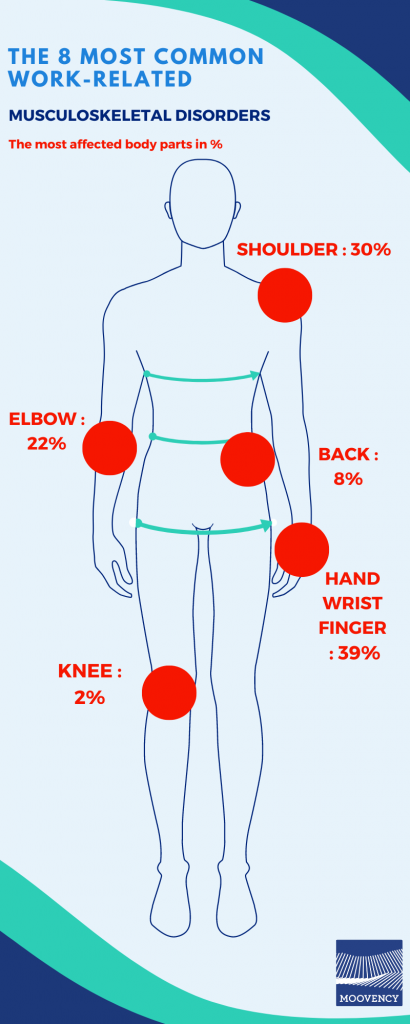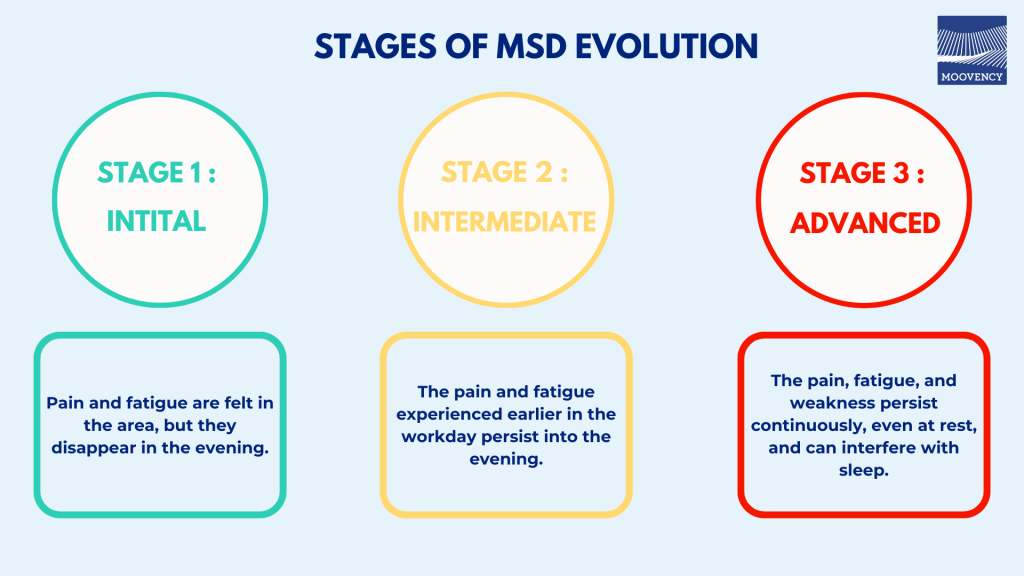The 8 most common work-related musculoskeletal disorders
We often hear about musculoskeletal disorders (MSD) and associated risk situations, but do you know how to properly identify their symptoms and the injuries they can cause ?
Having a good understanding of musculoskeletal injuries and knowing how to prevent them is essential for maintaining the health of employees and their productivity at work.
MSD mainly affects the neck, shoulders, back, as well as the upper (elbows, hands, wrists) and lower limbs (knees). We have prepared an infographic of the most common musculoskeletal disorders related to the work environment.
Shall we look together ?

How to define these pathologies ?
- ROTATOR CUFF SYNDROME: The rotator cuff refers to 4 tendons in the shoulder, which may undergo damage (rupture) of one or more tendons.
- CERVICALGIA: It refers to pain characterized by a state of muscle contraction and stiffness in the neck tissues.
- EPICONDYLITIS / EPITROCHLEITIS: Elbow tendonitis, with epicondylitis affecting the tendons of the outer surfaces while epitrochleitis affects the inner surfaces of the elbow.
- LOW BACK PAIN: Pain in the lumbar vertebrae expressed in various ways: stiffness, acute pain, blockage (lumbago)…
- QUERVAIN’S SYNDROME: It corresponds to inflammation of the wrist tendons.
- CARPAL TUNNEL SYNDROME: A common condition affecting the first three fingers of the hand, caused by compression of the median nerve in the carpal tunnel, located at the wrist.
- GUYON’S CANAL SYNDROME : It involves compression of the ulnar/cubital nerve at the wrist, responsible for the sensitivity of the inner half of the ring and little finger (fourth and fifth fingers).
According to various studies, the prevalence of these injuries is relatively significant.

For example, cervical and dorsal pains are very common reasons for absenteeism ; their frequency increases with age and affects half of individuals over 60 years old. In 2017, 20% of workplace accidents were related to back pain, and low back pain was the leading cause of disability before the age of 45.
MSDs : How to spot the symptoms ?
There are different stages of musculoskeletal disorders’ progression: initially benign, they can worsen if the symptoms are not identified early enough. Pain is an important warning signal that should not be ignored, as the injury can become chronic or even irreversible.

MSDs : How to prevent them ?
But don’t panic, it is possible to prevent and avoid MSD in your organization by implementing collective protection measures. Through an effective MSD prevention approach, it is possible to reduce the number of workplace accidents and, consequently, musculoskeletal injuries, while improving the quality of life at work for your employees.
Would you like to implement a comprehensive prevention approach but don’t know where to start?
MOOVENCY accompanies you in MSD prevention and offers turnkey or tailor-made services to quantify risks. Contact us !
Sources :
- AMELI – https://www.ameli.fr/assure/sante/themes/tms/comprendre-troubles-musculosquelettiques
- INRS – https://www.inrs.fr/risques/tms-troubles-musculosquelettiques/effets-sante.html
- AGENCE EUROPEENNE POUR LA SANTE ET SECURITE AU TRAVAIL – https://osha.europa.eu/fr/themes/musculoskeletal-disorders
- CENTRE CANADIEN D’HYGIENE ET SECURITE AU TRAVAIL – https://www.cchst.ca/oshanswers/diseases/rmirsi.html
- BIRON – https://www.biron.com/fr/centre-du-savoir/petit-guide-biron/troubles-musculosquelettiques/#22-128420
